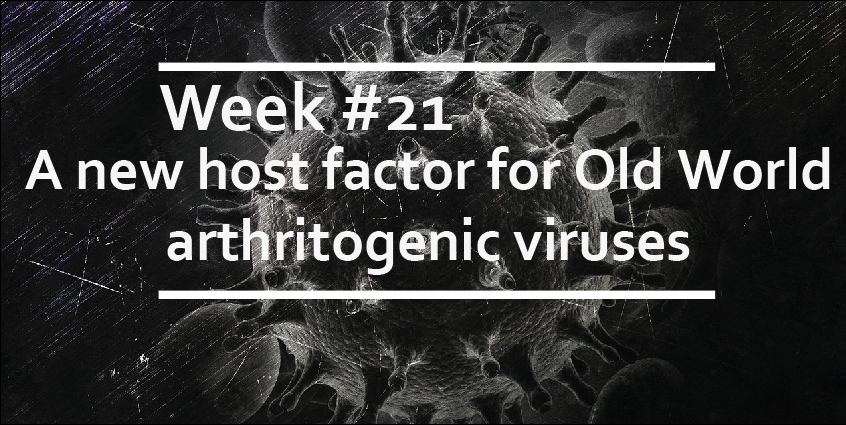A new host factor for Old World arthritogenic viruses
Old World and New World alphaviruses
Alphaviruses are mosquito-transmitted viruses that cause a range of human diseases, with manifestations varying from fever or rash to significant inflammatory pathologies, including encephalitis and severe arthritis. Alphaviruses are usually divided into so-called Old World and New World viruses, with Old World viruses mostly represented by arthritogenic viruses, which are associated with rheumatic disease in humans, and New World viruses (which include Venezuelan, Eastern and Western Equine Encephalitis viruses) primarily associated with severe encephalitic manifestation.
The arthritogenic alphaviruses
The arthritogenic alphaviruses comprise Ross River virus, Barmah Forest virus, o’nyong-nyong virus, Mayaro virus, chikungunya virus, and Sindbis virus. The potential of these viruses to cause chronic debilitating arthropathy combined with their ability to cause large-scale epidemics makes alphavirus-associated disease an illness of major socioeconomic concern.
What’s the receptor?
The cellular receptor of alphavirus has remained elusive up until now. The reasonably broad tropism of these viruses in tissue culture suggests either broad receptor distribution or the existence of multiple receptors. To investigate this, Zhang et al. performed a genome-wide CRISPR-Cas9 screen in search for arthritogenic alphaviruses’ receptors.
The authors transduced fibroblasts with lentiviruses delivering single-guide RNAs (sgRNA) targeting 20,611 mouse genes, and then infected these cells with a cell culture-adapted vaccine strain of chikungunya (CHIKV). After iterative rounds of viral infection, cell sorting, and propagation, genomic DNA was extracted for deep sequencing. By analysing the frequency of sgRNA sequences, the Mxra8 gene ranked as the top candidate. MXRA8 is an adhesion molecule found in mammals, birds and amphibians, and is expressed in epithelial, myeloid, and mesenchymal cells.
Confirmation and validation
When a gene is assigned a novel function, much work is needed to confirm and validate the findings, and this case was no exception. Below we summarise some of the efforts by Zhang et al. to confirm their exciting finding.
- The findings were reproduced using multiple sgRNAs, CHIKV strains, and cell lines.
- Mayaro, Ross River, O’nyong nyong and Barmah Forest viruses showed reduced infection in ΔMxra8 3T3 cells, while Semliki forest and Getah viruses showed partial phenotype. However, Sindbis, Bebaru, Una, and Middleburg viruses showed little dependence on Mxra8, suggesting that additional receptors may play a role.
- Humans have four isoforms of the MXRA8 gene. Two of these, MXRA8-1 and MXRA8-2, were shown to enhance CHIKV infectivity when overexpressed in HeLa cells, and reduce CHIKV infectivity when silenced.
- MXRA8 does not affect translation or replication but does mediate binding and entry, as a panel of different monoclonal antibodies against MXRA8 were shown to inhibit CHIKV.
- By using surface plasmon resonance, the authors show that Mxra8 binds to CHIKV directly, with a slow association rate and long half-life
- Although higher-resolution structural experiments are needed to define the complete footprint of binding between Mxra8 and the CHIKV E2 protein, mutagenesis mapping studies suggest that amino acids in the E2 A and B domains contribute to the interaction of CHIKV with Mxra8
- The expression of MXRA8 was tested on specific primary human cells, all of which are targets of infection by alphaviruses (keratinocytes, dermal fibroblast, synovial fibroblasts, osteoblasts, chondrocytes and skeletal muscle cells). Pretreatment with anti-MXRA8 blocking antibodies inhibited infection of CHIKV in all cells, except keratinocytes, which lack MXRA8 This, together with the absence of an apparent mosquito orthologue of mxra8, suggests that additional receptors contribute to cell binding and entry.
- Finally, the authors evaluated the role of MXRA8 in vivo by transferring hamster anti-Mxra8 antibodies into mice intraperitoneally 12 h before CHIKV inoculation. When comparing anti-Mxra8 to control antibody-treated mice, the authors detected reduced CHIKV titres in the ipsilateral ankle, calf muscle, contralateral ankle in the anti-Mxra8 mice. Treatment with anti-Mxra8 antibodies also reduced foot swelling. When anti-Mxra8 antibodies were administered at 8 or 24 h after virus inoculation the authors detected reduced CHIKV infection in the contralateral ankle and muscle, suggesting a function for Mxra8 in the pathogenesis of arthritogenic alphaviruses.
While more studies are require to understand the exact mechanism of receptor-virus interaction and the precise role of MXRA8 in the entry of alphaviruses that appear to only partially depend on MXRA8 expression, this work characterises for the first time the receptor of a number of medically relevant arthritogenic alphaviruses. This may have important therapeutic implications in the development of novel antiviral strategies, and also inform the vaccine design. This significant effort by Zhang et al also reiterates the power of high-throughput screening to advance our knowledge of viruses and their interaction with the host.
If your research involves a screening element, please get in touch to discover how your project could benefit from our screening services.




